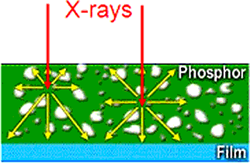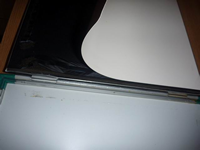X-Rays: Intensifying Screens Intensifying Screens
One form of intensifying screen consists of lead foil, or a thin layer of a lead compound evenly coated on a paper backing. Under the excitation of x-rays of short wavelength and gamma rays, lead is a good emitter of electrons, which expose the sensitive film, thus increasing the total photographic effect. Another form of intensifying screen consists of a powdered fluorescent chemical-- for example, calcium tungstate, mixed with a suitable binder and coated on cardboard or plastic. Its action depends on the fact that it converts some of the x-ray energy into light, to which the film is very sensitive. The decision as
to the type of screen to be used-or whether a screen is to be used at
all-depends on a variety of circumstances, and is made by the radiographer. Types of Film
X-ray films are commonly coated with emulsion on both sides of the support (to double the chance of exposure and therefore decrease the dose) --the superposition of the radiographic images of the two emulsion layers doubles the density and hence greatly increases the speed at which the X-Ray image is formed (halving the dose to the patient). X-ray films coated on one side only (single-coated films) are available for use when the superposed images in two emulsions might cause confusion - when a very detailed image of an area is required. |
Follow me...
|


 X-ray and other photographic films are sensitive to the direct action
of the x-rays, but the photographic effect can be increased very appreciably,
and exposure time can be decreased by the use of an intensifying screen
in contact with each side of the film.
X-ray and other photographic films are sensitive to the direct action
of the x-rays, but the photographic effect can be increased very appreciably,
and exposure time can be decreased by the use of an intensifying screen
in contact with each side of the film.  Several special
types of x-ray film have been designed for the radiography of materials.
Some types work best with lead screens, or without screens. Other types
are intended primarily for use with fluorescent intensifying screens.
Several special
types of x-ray film have been designed for the radiography of materials.
Some types work best with lead screens, or without screens. Other types
are intended primarily for use with fluorescent intensifying screens. 


